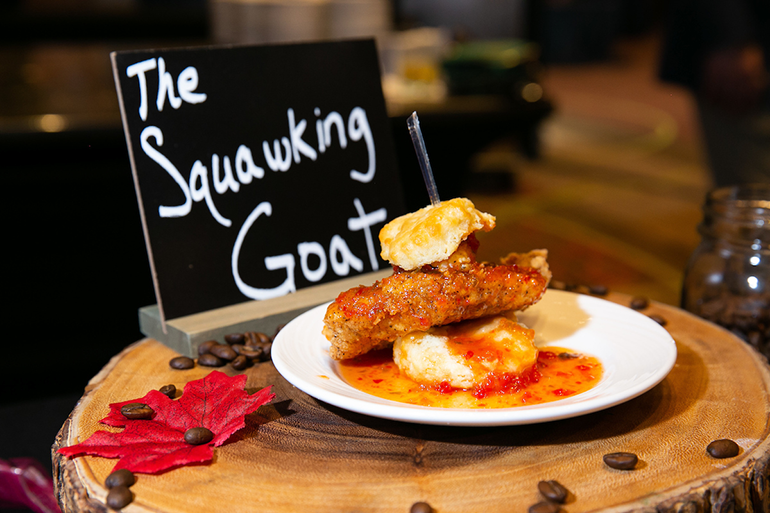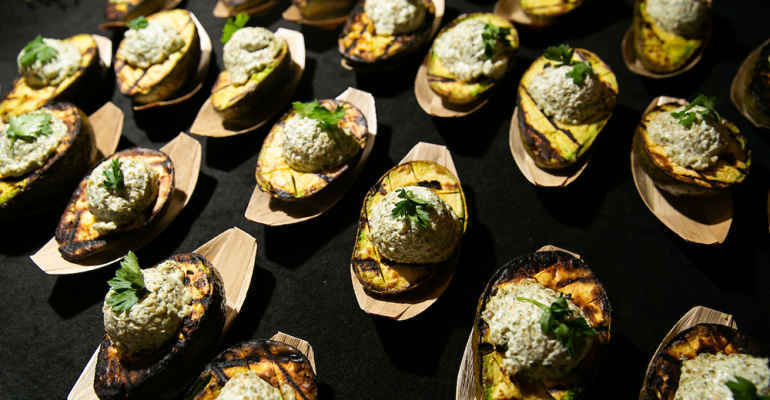This is part of Nation’s Restaurant News' special coverage of the 2019 MUFSO conference, which took place Oct. 14-16 at the Sheraton Denver Downtown.
What does it take to stand out as an up-and-coming restaurant brand? At the 2019 MUFSO conference in Denver, Colo. This year’s class of Hot Concepts winners shared key insights into some of the biggest challenges facing restaurant and hospitality businesses today, from delivery strategies to labor struggles.
For 25 years, the Hot Concept awards have celebrated emerging brands that are tapping into the right trends. Nation’s Restaurant News honors five restaurant concepts poised for regional or national growth.
The MUFSO Hot Concepts Super Session panel featured Michelle Gauthier, founder and CEO of healthy fast-casual concept, Mulberry & Vine; Michael Lastoria, co-founder and CEO of anti-establishment pizza chain, &pizza, Scott Moore, founder of the Southern comfort food concept, Maple Street Biscuit Company; Michael Rosen, founder and managing partner of chicken and egg chain, the Crack Shack; and Tom Small COO of made-to-order salad concept, Garden Bar by Evergreens.

The Squawking Goat fried chicken and biscuit sandwich from Hot Concepts winner Maple Street Biscuit Company.
Here is advice from the award winners:
Get creative with your off-premise strategy
One of the biggest headaches facing quick-service and fast-casual businesses is how to approach the rapidly growing delivery economy. With the added pressure of joining the third-party delivery wave, &pizza decided to find a creative way to invest in their delivery business: mobile kitchens. Unlike stationary ghost kitchens, &pizza’s mobile restaurants are kitchens on wheels that are larger than traditional food trucks. The mobile kitchen fleet helps delivery zones by allowing &pizza employees or “tribe members” to make pizza on the go inside the trucks:
“From a delivery standpoint we wanted to cover more delivery zones,” &pizza CEO Michael Lastoria said. “How do you get there faster? By flooding a market and having more penetration. You can text order from our trucks and pick it up there or we will come to you. It maximizes delivery capability without sacrificing quality. Because if that pizza shows up dead, cold, or sad, then someone won’t order from you anymore.”
Make your employees feel trusted
With labor being the number one concern on nearly every operator’s mind as turnover remains sky-high industry-wide, employee retainment has to be about more than just wages and basic benefits.
For Mulberry & Vine’s Michelle Gauthier, company culture starts with making her store-level employees feel like they are trusted and valued members of the team instead of just replaceable cogs in a machine:
She gives employees full-reign to dole out customer service and even surprise and delight-style freebies to customers as they see fit. Employees also have access to their store financial information, so they are well-aware of how their store is doing.
“We always find the yes — a concept that applies to customers and employees,” Gauthier said.

Kimchi bowls from Hot Concepts winner Garden Bar.
Don’t ignore your in-store experience for delivery
Although delivery has become one of the biggest opportunities for operators — nearly 60% of all foodservice experiences are now off-premise, according to National Restaurant Association data — you should never put all of your eggs in one basket.
“Our production line is right in front of the guest so there would be nothing worse than having that experience where you walk in and the team member looks down, proceeds to ignore the guest, and then they start to make a salad and it’s for a third-party delivery pickup,” Garden Bar’s Tom Small said.
At Garden Bar, they want to be sure that the pickup customer gets just as much attention as the delivery customer. They implemented secondary production lines for employees that separate salad-making for third-party and catering orders, so it does not interrupt the flow of guests coming into the store.
“The in-store experience is still where it is for us,” Small said. “We don’t want that to suffer.”
Food quality should not suffer to cut store costs
As the fast-casual and quick-service customer becomes more discerning, the last thing an operator should sacrifice for the bottom line is food quality. For Crack Shack founder Michael Rosen, making the decision where to cut in favor of upscale ingredient quality was a tough one:
“We thought if we want to use same chicken a Michelin star restaurant can serve, then we had to decide where to cut and we decided to cut labor,” Rosen said.
He emphasized that just because they are a fast-causal restaurant does not mean they can afford to skimp on ingredient quality. The result of investing in food over labor?
“We are a counter style restaurant and people wait on a long line (hopefully) and they put in their order and it might take a little longer,” Rosen said.

The MUFSO Hot Concepts Super Session panelists.
Invest in customer experience
Customer experience might be hard to pin down, but it’s absolutely essential to nabbing the attention of younger consumers:
“Millennials might not own a car but they’re willing to pay for the experience of going out to eat,” Maple Street Biscuit Company founder Scott Moore said.
For Moore, the “experience equation” comes down to a maintaining a balance between a unique atmosphere, food quality, quality of service and appealing to the “foodie” customer who is willing to spend more on the social experiences that they value.
Contact Joanna Fantozzi at [email protected]
Follow her on Twitter: @joannafantozzi





